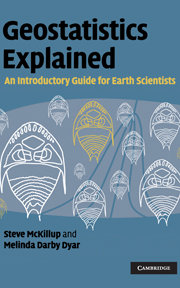Book contents
- Frontmatter
- Contents
- Preface
- 1 Introduction
- 2 “Doing science”: hypotheses, experiments and disproof
- 3 Collecting and displaying data
- 4 Introductory concepts of experimental design
- 5 Doing science responsibly and ethically
- 6 Probability helps you make a decision about your results
- 7 Working from samples: data, populations and statistics
- 8 Normal distributions: tests for comparing the means of one and two samples
- 9 Type 1 and Type 2 error, power and sample size
- 10 Single-factor analysis of variance
- 11 Multiple comparisons after ANOVA
- 12 Two-factor analysis of variance
- 13 Important assumptions of analysis of variance, transformations and a test for equality of variances
- 14 Two-factor analysis of variance without replication, and nested analysis of variance
- 15 Relationships between variables: linear correlation and linear regression
- 16 Linear regression
- 17 Non-parametric statistics
- 18 Non-parametric tests for nominal scale data
- 19 Non-parametric tests for ratio, interval or ordinal scale data
- 20 Introductory concepts of multivariate analysis
- 21 Introductory concepts of sequence analysis
- 22 Introductory concepts of spatial analysis
- 23 Choosing a test
- Appendices
- References
- Index
1 - Introduction
Published online by Cambridge University Press: 05 June 2012
- Frontmatter
- Contents
- Preface
- 1 Introduction
- 2 “Doing science”: hypotheses, experiments and disproof
- 3 Collecting and displaying data
- 4 Introductory concepts of experimental design
- 5 Doing science responsibly and ethically
- 6 Probability helps you make a decision about your results
- 7 Working from samples: data, populations and statistics
- 8 Normal distributions: tests for comparing the means of one and two samples
- 9 Type 1 and Type 2 error, power and sample size
- 10 Single-factor analysis of variance
- 11 Multiple comparisons after ANOVA
- 12 Two-factor analysis of variance
- 13 Important assumptions of analysis of variance, transformations and a test for equality of variances
- 14 Two-factor analysis of variance without replication, and nested analysis of variance
- 15 Relationships between variables: linear correlation and linear regression
- 16 Linear regression
- 17 Non-parametric statistics
- 18 Non-parametric tests for nominal scale data
- 19 Non-parametric tests for ratio, interval or ordinal scale data
- 20 Introductory concepts of multivariate analysis
- 21 Introductory concepts of sequence analysis
- 22 Introductory concepts of spatial analysis
- 23 Choosing a test
- Appendices
- References
- Index
Summary
Why do earth scientists need to understand experimental design and statistics?
Earth scientists face special challenges because the things they study – the rock formations, ore bodies, deposits of minerals and fossil species – are often very large, widely dispersed and/or difficult to access. Therefore, it is usually impossible for an earth scientist to study more than a small fraction of any geological phenomenon. For example, imagine trying to measure the length of every brachiopod in the northern hemisphere, the H2O content of every basalt flow in the USA, the diameter of every volcanic bomb on the island of Hawaii, or the orientation of every single fault plane in an entire formation. You would have to take a sample – a small subset of each – and hope that the results you obtained were representative of the larger group.
Because they are often forced to work with samples, earth scientists need to know how to sample, and they need to know how confident they can be about making generalizations from these samples.
The total number of occurrences of a particular thing (e.g. mineral species, fossil type, rock type) present in a defined area is often called the population. But because a researcher usually cannot measure every part of the population (unless they are studying a very restricted location, like the inside of a volcanic caldera), they have to work with a carefully selected subset of several sampling units that they hope is a representative sample, which can be used to infer the characteristics of the population.
- Type
- Chapter
- Information
- Geostatistics ExplainedAn Introductory Guide for Earth Scientists, pp. 1 - 7Publisher: Cambridge University PressPrint publication year: 2010

